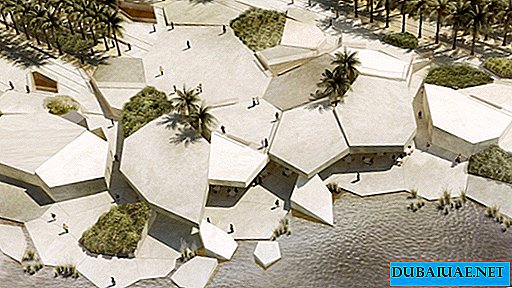Al-Hosn Cultural Center will open in Abu Dhabi, which will include the Qasr al-Hosn Palace Fortress, the Cultural Center, the National Advisory Council and the Craft House.

The Abu Dhabi Department of Culture and Tourism (DCT Abu Dhabi) today announced the long-awaited grand opening ceremony for al-Hosn, a new cultural attraction located in the heart of central Abu Dhabi, scheduled for December 7, 2018.
Al-Hosn is the original fashion district of the city, which will include four interconnected elements: the historical fortress-palace of Qasr al-Hosn, the Cultural Center, the Building of the National Advisory Council, as well as the House of Crafts. The official opening will be accompanied by lengthy festivities dedicated to the rich history and culture of Abu Dhabi, including a program of social events.
Qasr al-Hosn is the oldest and most important cultural heritage site in the city of Abu Dhabi, which includes two iconic buildings: the Inner Fortress, whose history goes back to 1795, and the Outer Palace, built in the 1940s. This building, a living witness to the history of Abu Dhabi, over the past two centuries has managed to serve as the residence of the ruling family, a meeting place for the government, an advisory board and a place to store state archives. Now, after the completion of lengthy, large-scale and meticulous restoration and conservation works, Qasr al-Hosn has been turned into a museum, a national monument that allows you to trace the history of the city from the time when there was a settlement in its place, whose inhabitants were fishing and searching in the XXVIII century pearls, until today, when it turned into a modern global metropolis with a dynamic business center and skyscrapers surrounding the fortress.

The restored and updated premises of the Cultural Center will host a varied program of events dedicated to the visual and entertainment arts, as well as open the first children's library in the region. In honor of the December opening, the Center for Fine Arts will present an exhibition on the history of the building, which served as a center of attraction for local artists. The Cultural Center will open in stages, in particular, access to the Center for Fine Arts, which will house exhibition halls and artists' studios, will be opened on December 7. Two more objects - the theater and the Children's Library, are planned for opening in 2019.
CULTURAL AND HISTORICAL OBJECT AL-HOSN
The cultural and historical site of Al-Hosn was designed in such a way as to recreate the fortress-palace of Qasr al-Hosn against the backdrop of the coastal landscape, in an urban environment, due to the rapid growth of the city; it is a tribute to the historical heritage of the Emirates and an expression of their identity, both through the past and through the present.
The comprehensive development plan provides for diagonal division into two parts, each of which is distinguished by its unique and special character. On the one hand is the historical part around the fortress-palace of Qasr al-Hosn, recreating the original appearance of a lonely building on the background of a sandy plain, with an organic and natural landscape of the coastal desert. On the other hand - the modern part around the Cultural Center, dedicated to the cultural and historical heritage and intended for various cultural events; it is planned according to the principle of a city grid, has an emphasized man-made, geometrically-drawn look, and is replete with straight lines.

KASR AL-HOSN
Qasr al-Hosn is of particular importance to Abu Dhabi and its people. Name Hosn It belongs to the Inner Fortress, built in 1795, and which included the first capital city construction, a watchtower made of coral and sea stone to protect the settlement that arose on the island in the 1760s. Qasr belongs to the Outer Palace, which was built around the Inner Fortress by Sheikh Shahbat bin Sultan Al-Nahyan in the 1940s as a residence for the ruling family and a venue for meetings of the ruler’s mejlis. During the reign of Sheikh Shahbat bin Sultan Al-Nahyan, an economic transition took place from pearl fishing to oil production, and in the following decades, the structure and functions of the fortress-palace of Qasr al-Hosn gradually changed, it ceased to be the center of political power and the home of the ruling family, turning into a cultural city center.
The Inner Fortress and Outer Palace of Qasr al-Hosn are the main "reference points" in the history of Abu Dhabi, telling about the city and its people, their history and modern heritage. Permanent exhibitions in its premises will allow visitors to receive multifaceted impressions, creating the idea of Qasr al-Hosn fortress as a constant witness, narrating about the formation of Abu Dhabi; they will help them penetrate the lives of men, women and children living in the Outer Palace; as well as tell about the restoration of fortress structures. In addition to the permanent collection, the exhibitions will include temporary exhibits of archival materials, audio-visual materials, supplemented by interactive tools.
The public program on the territory of the Qasr al-Hosn fortress will include special excursions on archeology and architecture; reconstruction of scenes from everyday life and rituals held in the fortress; there will be a program dedicated to the Majlis, with which visitors can get acquainted with the history and significance of the Majlis; In addition, activities for children and youth are provided.

CULTURAL CENTER
The Cultural Center, founded by the late Sheikh Zayed bin Sultan Al-Nahyan in 1981, became the first multidisciplinary non-profit cultural center in the region, conceived as a public institution for the development of all forms of intellectual and creative activity. He was called to implement the idea of Sheikh Zayed about the need to promote the cultivation of cultural identity and self-identification of citizens of the young nation of the UAE.
The center, which includes the National Library, a wing for the performing and spectacular arts, as well as an exhibition hall and artists' workshops located in the middle, has become a haven of culture, a platform for the exchange of knowledge and discussions between artists, poets, intellectuals and scientists, as well as a favorite place for everyone meeting friends and family members. The Cultural Center, which has become a point of attraction for cultural events in the UAE and the region, hosted numerous first exhibitions of local and regional artists, and has become for Abu Dhabi a window for exchanging ideas and for communicating with people from around the world.
The long-awaited opening of the Cultural Center was preceded by large-scale restoration work, including major modernization projects, in particular, the construction of the first children's library in the region, an impressive gallery of fine arts in the open air, exhibition spaces located both indoors and outdoors, and a 900 theater places and an open amphitheater, classrooms and workshops, as well as catering facilities.
On December 7, the Cultural Center will begin to gradually open to the public, presenting the updated Center for Fine Arts, two exhibition halls and artists' studios, in which various events will be held all year round, including open studios, art exchange programs with artists invited for temporary work, lectures , art classes and workshops. A special exhibition of works by UAE artists at the Center for Fine Arts, dedicated to the history of the building as a meeting place for people of creative professions, will be timed to coincide with the December opening. The mission of the Cultural Center will also include support and implementation of creative initiatives aimed at developing the cultural landscape of Abu Dhabi. The theater and the Children's Library will open in 2019.

HOUSE CRAFTS
Next to the fortress-palace of Qasr al-Hosn and the Cultural Center, the House of Crafts will open, which will serve as the focus of activities to promote and preserve the tangible and intangible historical heritage of the UAE. In 2011, UNESCO listed al-Sad as a weaving craft on the List of Intangible Cultural Elements in urgent need of conservation, and the Crafts House was founded as a result of joint efforts to protect and support this and other traditional crafts of the Emirates and craftsmen practicing these crafts.
The Crafts House will not only serve as a center for the preservation and demonstration of traditional crafts of the United Arab Emirates, but will also contribute to the fulfillment of the vital task of transferring the knowledge, skills and abilities associated with these crafts in order to preserve them for future generations. Paying special attention to such types of folk art as weaving, palm fiber weaving and embroidery, the Crafts House will strive to transfer these traditional forms of craftsmanship of the past into modern culture, and plans to organize training courses, educational seminars and other public events.












